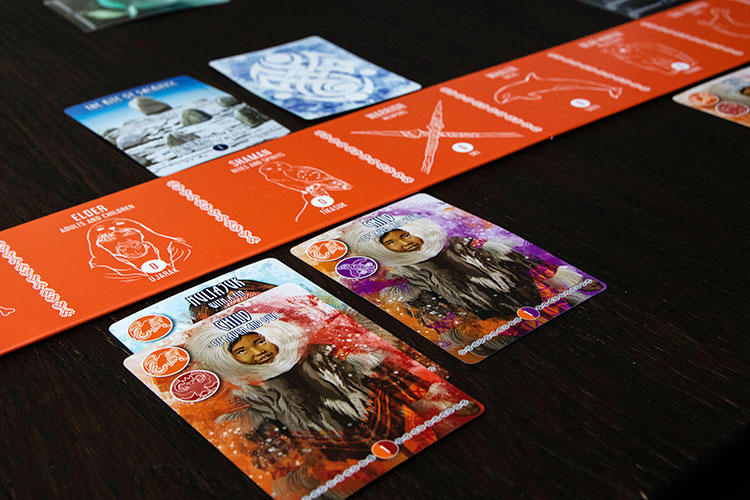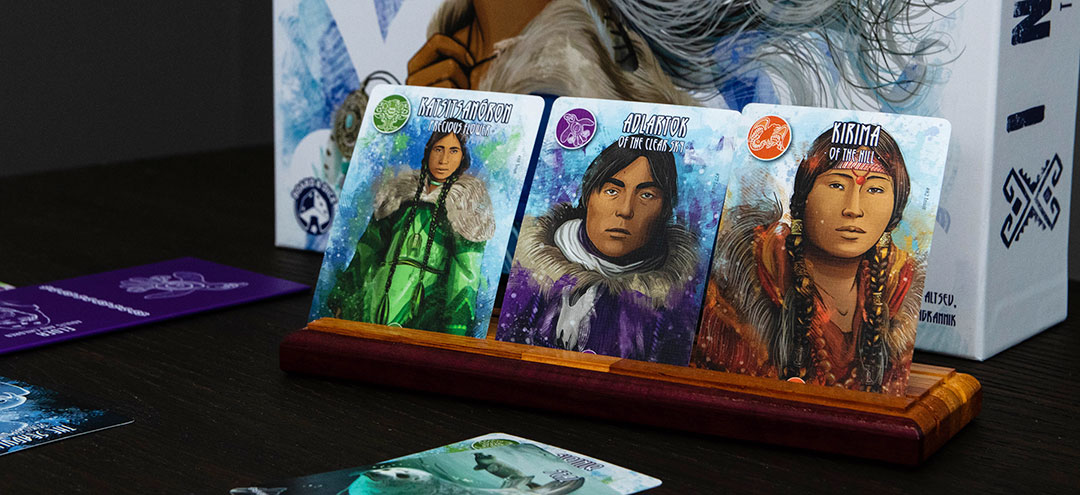 When it comes to board games, there are lots of different routes a publisher can go to grab your attention. One of the most important is the artwork they choose to put on the front of the box. I’ll admit, that is all it took to pique my interest in Inuit: The Snow Folk. The white and blue cover just stands out from the crowded mess of boxes you’ll find in your game store.
When it comes to board games, there are lots of different routes a publisher can go to grab your attention. One of the most important is the artwork they choose to put on the front of the box. I’ll admit, that is all it took to pique my interest in Inuit: The Snow Folk. The white and blue cover just stands out from the crowded mess of boxes you’ll find in your game store.
Staring at a box is only entertaining for so long though. So let’s take a look at how it actually plays once you open the thing up.
Inuit: The Snow Folk is a card drafting game for 2-4 players. It plays in about 30 minutes and plays best with 3 or more people.
Gameplay Overview:
Each player controls an Inuit village as they attempt to rise to prosperity through gaining new villagers, hunting wild game, and performing rites to please the spirits.

During setup, five cards are revealed into the center of the table to form the Great White. Each turn you’ll add at least one card to the Great White and then draft one or more cards into your own village. At the beginning of the game, you’ll have one villager of each occupation so you’ll only be able to draft a single card. As you draft villagers, you can assign them to a job, which will allow you to take additional cards of that type. If you have shamans, for instance, you can claim up to 3 rites and/or spirits on a single turn.
Not every Inuit is necessarily from your village. You can draft Inuit cards that belong to other villagers and give them jobs, you’ll just score negative points for them at the end of the game. Alternatively, you can use your warriors to remove Inuit from the Great White and claim their weapons as additional victory points.
In addition to adding a card at the beginning of your turn, you can add additional cards for each scout you have in your village. This will give you additional choices, but it’s a careful balance as you can only use a single occupation each round and you’ll be adding more to the Great White for your opponents as well.
The game ends when the polar nightfall card is revealed (it’s shuffled near the bottom of the deck during setup). Play continues until everyone has had the same number of turns and then the player with the most points is the winner.

Game Experience:
As card drafting games go, Inuit: The Snow Folk is different than most of the other games on the market. Players will be drafting from essentially a shared pool and have some control over how many cards to add to that pool. This unique element almost feels like a minigame of seeing how far you can push your luck at times.
Early on you’ll want to acquire additional Inuit to your village to power up your other actions. Each village will have to plan carefully on where to place your Inuit you recruit as you can’t change their occupation once placed. It’s tempting to start by adding a few Elders, which allow you to recruit even more Inuit, but you’ll find yourself lacking in other abilities. Everything is a trade-off and depends largely on what other players seem to be aiming for and what you expect to be available.

Many of the rite cards also serve the function allowing players to catch up to the leader. They often force players to lose villagers or game cards that they’ve previously drafted. They can also be drafted defensively to prevent them from being used against you (although they only ever hurt the player with the most of something).
You can also just forget about all of that and focus on hunting wild game. There are three types in Inuit: seals, orcas, and polar bears. Seals are worth the least but are the most prevalent, polar bears are rare but worth the most, and orcas fall somewhere in the middle of both. This can inform your decision on how many Inuit you want to dedicate to each particular hunting occupation.
The most interesting decisions in Inuit are often when to stop adding cards to the Great White. Maybe you have three bear trappers but there are only two polar bears currently available. If you have scouts you can continue to flip cards, but if no bears come up and you end up just taking two anyway you’ve done nothing but increase the choices for everyone else. The end of the game also is dependent on how fast you get through the deck, so you may choose to scout aggressively if you think you are in the lead.

The box even includes two small expansion modules. The conflict module adds additional cards which permit you to either declare a war or alliance with another player. If you are at war you’ll earn additional points at the end of the game for defeating more of their villagers and having more warriors. It adds a bit more incentive to forcefully removing some of the villagers from the Great White rather than just adding them to your own village and I recommend adding it in most of the time.
The other expansion divides the game up into seasons, each which institutes a small rule change. These can have a big impact on the gameplay, but mostly just added bookkeeping. Rarely did they make the decisions more interesting and I don’t think I will use it going forward.
Final Thoughts:
I’m glad to say Inuit: The Snow Folk is more than just a pretty box. The gameplay is pretty light and accessible enough to be a family game that plays quickly. There is also plenty of interaction without the game feeling too mean.
There isn’t a ton that changes from game to game in Inuit, but the experience of making a different engine each game and making meaningful choices about when to add cards and what to take is worth the price of admission.
If you are in the market for a beautiful game that you can play with almost anyone, you should certainly consider Inuit: The Snow Folk.
Final Score: 4 Stars – A great lightweight engine builder that features amazing art.
 Hits:
Hits:
• Beautiful game with great table presence
• Engine building elements allow you to customize a strategy.
• Interesting decisions to make
• Easy to learn and teach
Misses:
• Not every game is going to feel completely unique.
• The expansion that adds different seasons is lackluster.






















